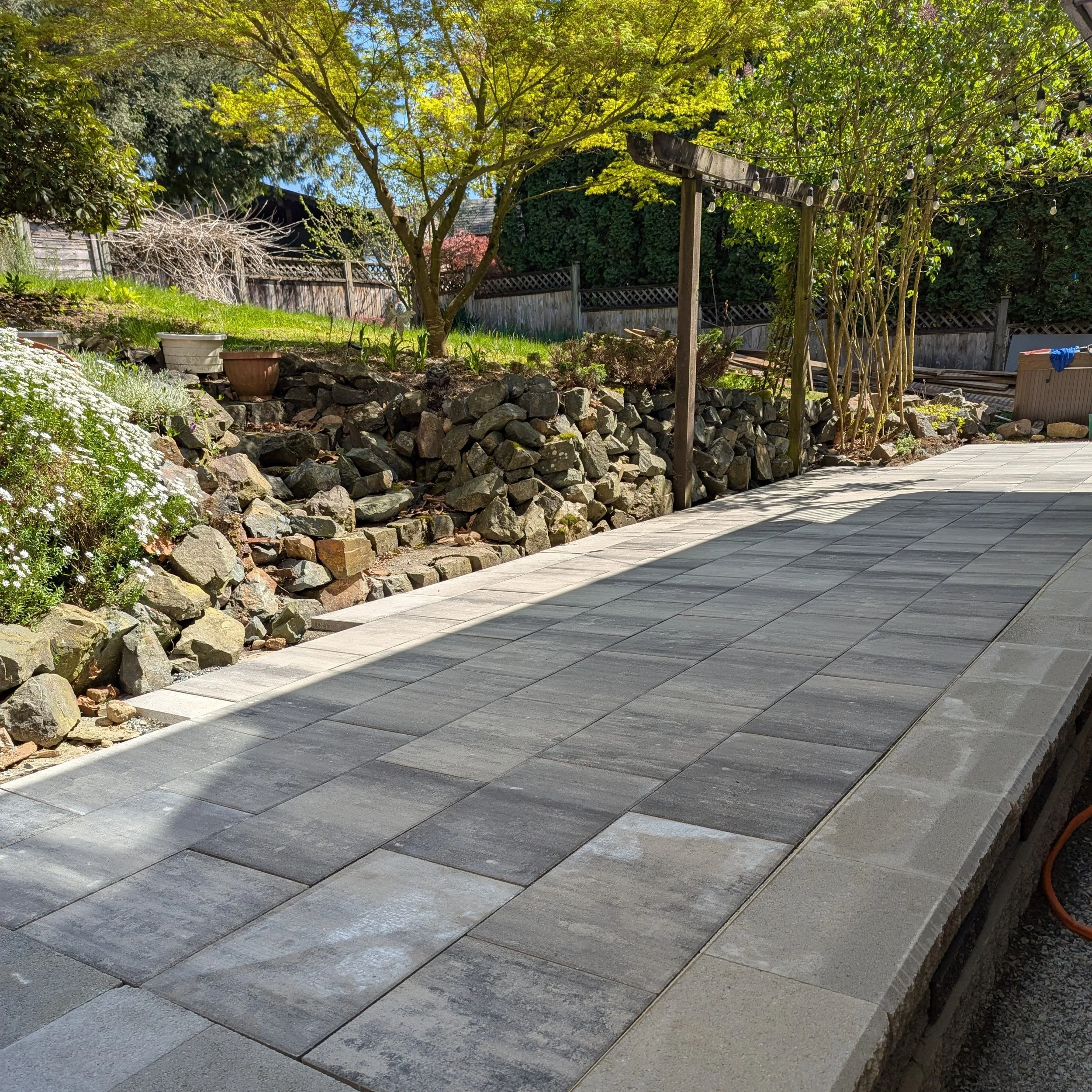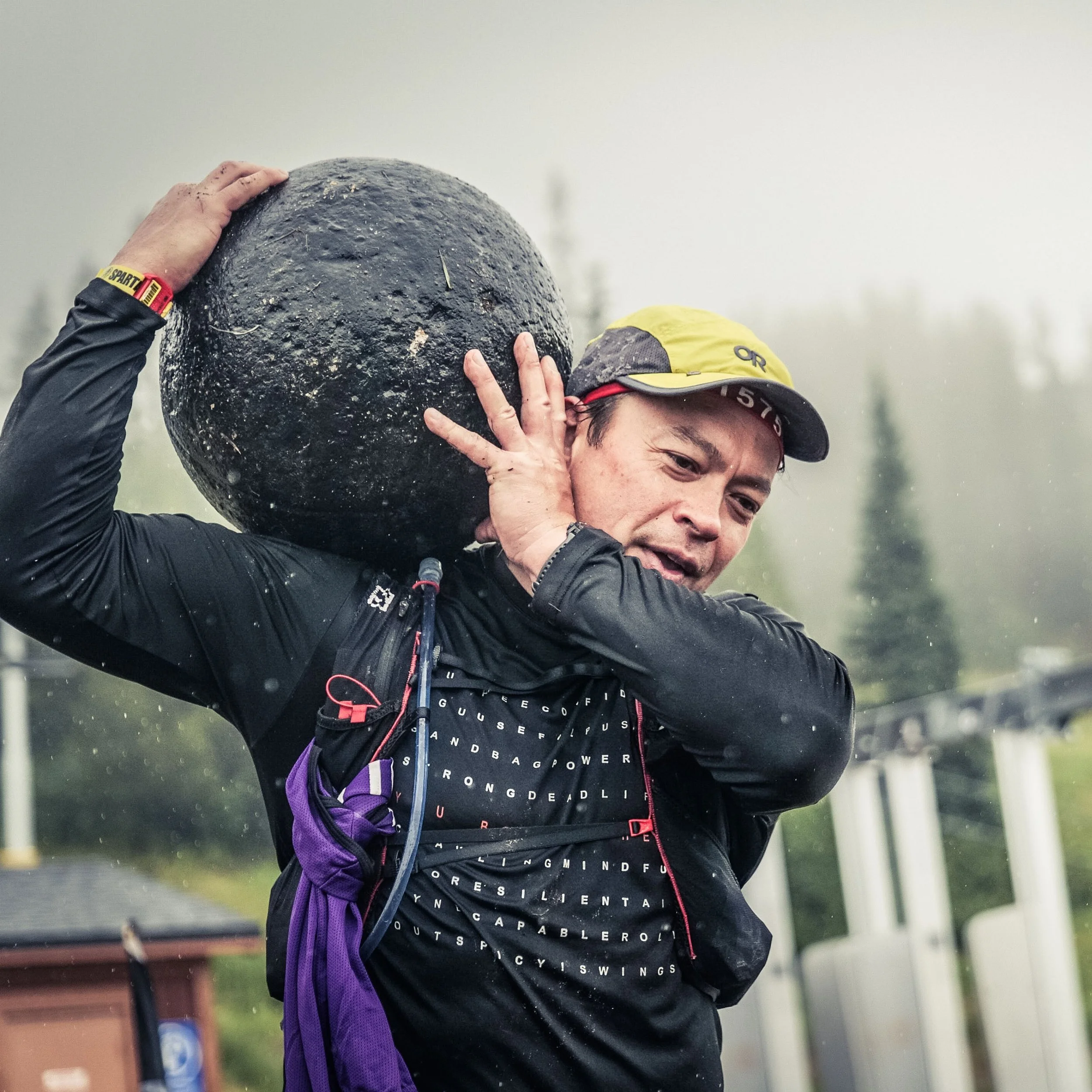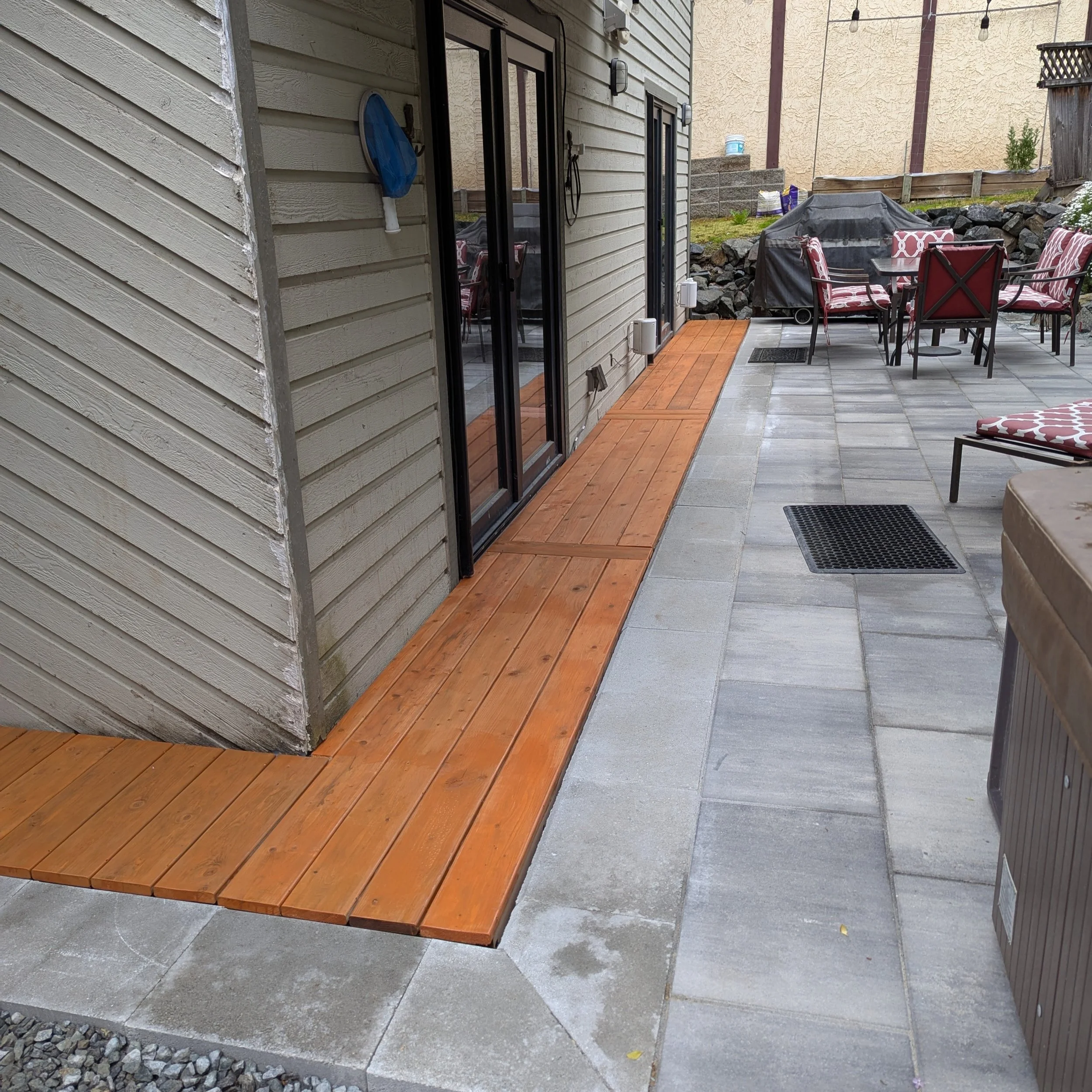What a Backyard Project (And A Decade Of Spartan Races) Taught Me About Real Strength
Earlier this year, I took on a project that, on paper, I probably had no business doing solo. My backyard needed a major overhaul — the old wooden deck was rotting, and I decided it was time to rip it out and replace it with a full paver patio and a retaining wall.
If you’ve ever underestimated a DIY project, you’ll know where this is going. What began in my head as a “weekend job” ballooned into weeks of effort. And not light effort either — this was a project that required moving literal tons of material by hand. I’m talking thousands of pounds of concrete blocks, pavers, gravel, sand, and stubborn clay soil. There were no machines, no hired crews, just me, a wheelbarrow, a shovel, a pick, and a refusal to quit once I’d committed.
Every day brought a multitude of different physical demands. One minute I was shovelling through hard-packed clay littered with rocks. The next, I was muscling blocks to and from awkward heights, manoeuvring them into place, then crawling down onto hands and knees to level the next row. I spent hours pushing overloaded wheelbarrows uphill over uneven ground, dumping them out, and heading straight back for more. Some days all I could squeeze in was 45 minutes between coaching clients and family responsibilities. Other days I worked as much as eleven hours straight under blazing sun, collapsing into bed with dirt still under my fingernails and a body buzzing from the grind.
And here’s the thing: at no point did I feel “wrecked.” Sore, yes. Tired, absolutely. But broken down? No. My body didn’t quit. In fact, what shocked me most was how resilient my back felt throughout the entire project, given the sheer scope and volume of heavy material I was dealing with. If you’ve ever done any kind of heavy manual work, you know the back is usually the first thing to protest — and yet, despite the demands, mine held up. I credit that to two decades of training: the foundation of strength I’d built, the mobility I’d maintained, and the feel for good (or at least “better”) mechanics that allowed me to adjust on the fly. Whether that meant balancing the load differently, shifting foot position, or pacing myself across the day, I found ways to get the work done without wrecking myself in the process.
That doesn’t mean there wasn’t apprehension going in. Honestly, the sheer scope of the project was daunting. I wasn’t sure I’d be able to manage it.
But I kept coming back to the old Georges Hébert maxim that has guided me for years: “Être fort pour être utile” — “Be strong to be useful.”
This project was the ultimate test of that philosophy. It wasn’t about aesthetics or gym numbers, it was about whether the years of training had actually made me useful — capable of taking on a real-world task that demanded every ounce of resilience, mobility, and strength I had.
And it did.
Despite weeks without a single run or traditional “cardio” session, my body leaned out. My arms and back grew more defined, my waist trimmed, and when I finally returned to the mountain trails, my climbing power was better than before. The project had tested me physically, yes, but it had also built me in ways the gym can’t replicate. I was certainly glad to see the end of it, don’t get me wrong, but I also walked away with a surprising sense: I could have done even more if I’d needed to.
Training should prepare you for life — not just for the mirror. It should give you the resilience to keep going, the durability to stay uninjured, and the confidence to tackle whatever life throws your way, whether that’s a DIY backyard overhaul, hauling luggage through a train station in Europe, or saying yes to an unexpected adventure with friends.
Training that transfers is training that matters. And that’s where we’re headed.
Who This Is Really For
If you’ve ever wondered whether the hours you spend in the gym actually matter outside of it, this is for you.
If you’ve thought, “Sure, I can deadlift a barbell, but why do I still tweak my back carrying boxes?” — this is for you.
If you’ve grown tired of training only for calorie burn, chasing aesthetics, or focusing on weight loss without ever feeling genuinely more capable in your day-to-day life — then this is definitely for you.
Because most people don’t really care about six-pack abs or biceps in isolation. What they want is what those things are supposed to represent:
The energy to keep up with their kids (or grandkids) without hesitation.
The confidence to carry their own luggage while travelling, no matter how awkward or heavy it is.
The ability to spend a weekend on yard projects or house renovations without needing three days to recover.
The freedom to say yes to adventures with friends and family without worrying whether their body can handle it.
That’s what training should give you: capability. It’s not about sculpting muscles for the mirror, it’s about building a body that actually works — one that can handle the messy, unpredictable demands of real life.
And if you’ve ever doubted whether that’s possible for you — if you’ve felt too old, too busy, too out of shape, or simply worn down by past attempts — know this: you’re not broken. You’re not behind. You just need to approach training with a different lens. That’s what this article is here to give you.
Barriers and Misconceptions
Before we get into the “how,” let’s clear up a few of the most common misconceptions about training for real-life capability.
1. Training is for weight loss.
This is one of the biggest traps. Training is a lousy weight loss tool on its own. Nutrition drives the majority of body composition changes. The real value of training isn’t calories burned — it’s capacity built. Strength, endurance, mobility, and resilience are the qualities that carry you into the rest of your life.
2. Functional fitness means mimicking real life.
I see this mistake often. People assume “functional training” means lugging grocery bags around the gym or pretending to shovel snow with a barbell. But just as with sports, mimicry rarely translates. You don’t get better at hockey by doing “gym hockey drills” — you get better by training the underlying principles (speed, agility, power) and then practising the sport itself. Life is no different. You don’t need to rehearse loading a suitcase onto a rack. You need the rotational strength, balance, and coordination that make it effortless when the moment comes.
3. If I look fit, I’ll be fit.
A six-pack doesn’t mean you can carry a tired child up a hill. Big arms don’t guarantee you can wrestle a heavy wheelbarrow uphill. Looks and capability aren’t the same thing. Train for function, and form tends to follow anyway — but in a way that’s actually useful.
4. Endurance only comes from cardio.
Another myth. Endurance isn’t just hours on a treadmill. It’s the ability to repeat varied efforts without breaking down. My backyard project taught me that, but so did another experience years earlier.
The Spartan Race That Changed My Thinking
Back in 2015, I signed up for the Spartan Race Sun Peaks Beast. At the time, I figured my background in traditional strength training and conditioning would be enough to carry me through. I’d spent years under barbells, building muscle, pushing hard in the gym. I knew how to grind.
But the Spartan Beast was something else entirely. Hours on steep mountain terrain. Hauling sandbags. Crawling under barbed wire. Climbing walls. Dragging heavy objects. Jumping, balancing, lifting, sprinting, and grinding through obstacles that seemed to come out of nowhere.
It was an eye-opener. I realised quickly that being strong in the gym was only part of the picture. The event demanded a much broader spectrum of capability: mobility, agility, rotational power, grip strength, endurance that lasted for hours, and the resilience to keep going when my body was screaming.
That race expanded my thinking. It showed me that real-world fitness isn’t about sterile, controlled lifts in a predictable environment. It’s about being able to adapt, to haul, to crawl, to endure — and to do it repeatedly. It was gritty, messy, and uncomfortable… but also incredibly real.
Since then, I’ve approached training differently. The classic staples (squats, deadlifts, presses) still matter. They build a foundation. But on their own, they’re not enough. To be truly capable, you need the odd-object lifts, the carries, the ground-to-standing transitions, the explosive movements, and the endurance that ties it all together.
That’s when training stops being about appearance or calorie burn, and starts being about life.
The Payoff of Training for Capability
So what do you really gain when you stop chasing calorie burn or mirror muscles and start training for capability? The difference is night and day.
Resilience
Resilience is the ability to keep going, not just once, but again and again. It’s not the strength to lift one heavy box, it’s the capacity to move a whole garage’s worth without breaking down. It’s not sprinting up one flight of stairs, it’s climbing twelve without huffing, and still being able to carry on a conversation at the top. It’s what let me spend weeks on that patio project without ever feeling like my body was giving out.
Mobility and Control
Mobility often gets overlooked until you don’t have it. The ability to bend, twist, and reach without strain might not sound sexy, but try gardening for a few hours without it, or getting on the floor with your kids and realising how stiff you feel. Training mobility and control gives you grace in awkward positions — the ability to move well through the messy angles life throws at you.
Durability
This is one of the most underrated qualities of all. A lot of people can grind through a workout. Fewer can do it for years without pain and injury. Durability is what protects your joints, tendons, and tissues over the long haul. It’s the difference between someone who has to “take a break” every time their back or knees flare up, and someone who just keeps showing up year after year.
Integrated Strength
In the gym, it’s easy to isolate muscles. Biceps curls, quad extensions, chest presses. But in life, muscles don’t work in isolation. They work together, from your feet through your core to your hands. That’s integrated strength — limbs and core working in sync to lift, carry, rotate, push, and pull as one unit. It’s what turns brute force into efficient movement.
Confidence
When you know your body can handle itself, you carry yourself differently. You stop second-guessing whether you can lift that bag, climb that hill, or say yes to that hike. You move through life with quiet assurance. That confidence doesn’t just change how you feel in your body — it changes how you show up in every part of life.
Freedom
And ultimately, that’s what all of this adds up to: freedom. The freedom to live the life you want without being held back by hesitation. The freedom to go travelling and explore all day without worrying about stamina. The freedom to play with your kids or grandkids on the floor without thinking about how you’re going to get back up. The freedom to tackle projects or adventures knowing your body can keep up.
This is why I keep coming back to the phrase form follows function. When you build a body that moves well, resists breakdown, and expresses strength in real-world ways, the aesthetics come along for the ride. You lean out. You build muscle. You look athletic. But it’s the capability underneath that truly matters — and it’s what makes the aesthetics sustainable, not fleeting.
Practical Strategies: How to Train for Real-Life Capability
Here’s where the rubber meets the road. You don’t need to overhaul your training entirely. You just need to sprinkle in the patterns that transfer best.
1. Push and Pull with Rotation
Life rarely happens in straight lines. Shovelling snow, swinging a suitcase into an overhead rack, pulling weeds — all involve rotation.
1-arm cable or band presses with a twist.
Rotational rows, archer pulls, renegade rows.
Medicine ball throws against a wall (or throws and catches with a partner).
2. Ground-to-Standing Patterns
One of the simplest but most overlooked measures of independence as we age is the ability to get up and down from the floor. Add load, and you’ve got gold.
Dumbbell or kettlebell Turkish get-ups and sandbag get-ups
Half-kneeling to standing presses.
3. Odd Object Carries and Lifts
Life is awkward. Sandbags, suitcases, laundry baskets — none of them come with ergonomic grips.
Sandbag shouldering, GTO’s and get-ups.
Farmer’s carries with heavy kettlebells.
Suitcase carries for core stability and overhead carries to toast the shoulders as well.
4. Jumping and Landing
Power isn’t just producing force — it’s absorbing it safely. Landing well means knees and hips that last.
Box jumps with controlled landings.
Broad jumps for horizontal power.
Jump squats and jump lunges for repeated elastic strength and eccentric load handling.
5. Single-Leg and Split-Stance Strength
Most of life isn’t symmetrical. Walking, stepping, balancing while reaching — all require stability on one leg.
Bulgarian split squats.
Single-leg deadlifts.
Balance + reach drills with light weights.
👉 Start small: replace one “traditional” exercise each session with a transfer-focused pattern. Over time, your whole training base shifts toward capability without sacrificing the basics.
Common Mistakes to Avoid
Let’s make sure you don’t sabotage yourself. Here are the traps I see most often:
Going heavy too soon. If form collapses, you’re not training capability, you’re rehearsing injury. Nail mechanics first.
Skipping mobility. Strength without mobility is like horsepower without steering. Commit to joint prep and controlled ranges.
Redlining every session. You don’t need to crawl out of the gym to progress. Consistent, repeatable effort wins.
Ignoring recovery. Capability is built when you rest and rebuild, not just when you train. Sleep, fuel, and recovery practices are part of the plan.
Chasing novelty. Random “fun” workouts might feel good, but without progression, you stay stuck. Variety is fine — chaos isn’t.
Case Study: From the Backyard to the Spartan Beast and Beyond
The backyard project gave me one of the clearest reminders I’ve ever had of why I train the way I do. Weeks of lifting, carrying, hauling, and grinding tested every ounce of strength, resilience, and mobility I’d built. And the most surprising part was that I didn’t just survive it — I came out stronger. Leaner. More capable. When I returned to the trails, my endurance and climbing power were better than before.
But the truth is, this wasn’t my first eye-opener. Years earlier, my first Spartan Race — the 2015 Sun Peaks Beast — shook my understanding of what “fitness” really meant. I went into that race thinking years of barbell training and gym conditioning had me covered. What I discovered on the mountain was a whole different story. Hours of steep climbs, heavy carries, crawling, jumping, pulling, dragging — obstacles that tested me in ways a sterile gym environment never could.
That race changed me. It opened my eyes to the breadth of physical capability life can demand. It showed me that it wasn’t enough to be strong in controlled settings. Real resilience meant being able to adapt when things got awkward, unpredictable, and exhausting.
Over the past ten years, that lesson has been reinforced again and again. I’ve now run 32 Spartan Races — Sprints, Supers, Beasts — and last year, on my 50th birthday, I capped it off with my first Ultra, taking 2nd place in my age group. Along the way, I’ve trained and raced with dozens of people: first-timers tackling their very first obstacle race, seasoned athletes chasing Trifecta weekends, and everything in between.
And every single one of those races, every one of those shared experiences, has reaffirmed the same truth: form follows function.
The people who thrive at these events aren’t always the biggest, strongest, or fastest in the gym. They’re the ones who’ve built capability across the board: strength that integrates with mobility, endurance that couples with power, resilience that allows them to repeat effort after effort without breaking down. They’re the ones who’ve trained their bodies to handle the messy, awkward, unpredictable reality of life — and they carry that forward long after the race ends.
That’s why I train the way I do. It’s why I coach the way I do. Because at the end of the day, whether you’re hauling gravel in your backyard, running an obstacle race, or just living life fully, the goal isn’t to look like you can do it. The goal is to actually be able to do it.
Conclusion: Train for Life, Not Just Looks
At the end of the day, training that matters is training that transfers. It’s not about the numbers on a barbell, the calorie count on your smartwatch, or the size of your biceps in the mirror. Those things can be fun to track, but they’re not the point. The point is whether your body can carry you through the life you actually want to live.
My backyard project reminded me of that in the most practical way possible. Weeks of shovelling, hauling, and lifting didn’t break me down — they revealed the resilience and durability I’d built through years of training. And my decade of Spartan racing, culminating with an Ultra on my 50th birthday, has hammered home the same lesson: form follows function.
Looks fade. Numbers shift. But the strength, mobility, and confidence you build when you train for capability? That stays with you. It shows up when you need it most — whether that’s tackling a daunting DIY project, running an obstacle course, or simply keeping up with your kids or grandkids on a weekend adventure.
And that’s the real payoff. Not just looking fit, but being fit. Not just appearing strong, but feeling strong in every sense of the word. Not just burning calories, but building a body that works.
So here’s my challenge to you:
The next time you plan a workout, ask yourself not just “What will this do for my physique?” but “How will this make me more capable in life?”
Choose one exercise this week that trains capability — a carry, a crawl, a get-up, a rotational press — and add it to your session.
Notice how it feels, not just in the moment, but in the confidence it gives you for everything outside the gym.
Because that’s the goal. Training shouldn’t be a chore you grind through for aesthetics alone. It should be the practice that gives you the freedom to live fully — to say yes to projects, adventures, and everyday moments without hesitation.
Form follows function. Build capability first, and the rest will follow.
(And if you want support in building that kind of training — whether in-person here in Abbotsford or online — know that help is available. You can reach out via our Contact Us page. But even if you never step foot in my gym, let this article be the reminder: train for life, not just for looks. Your future self will thank you.)




